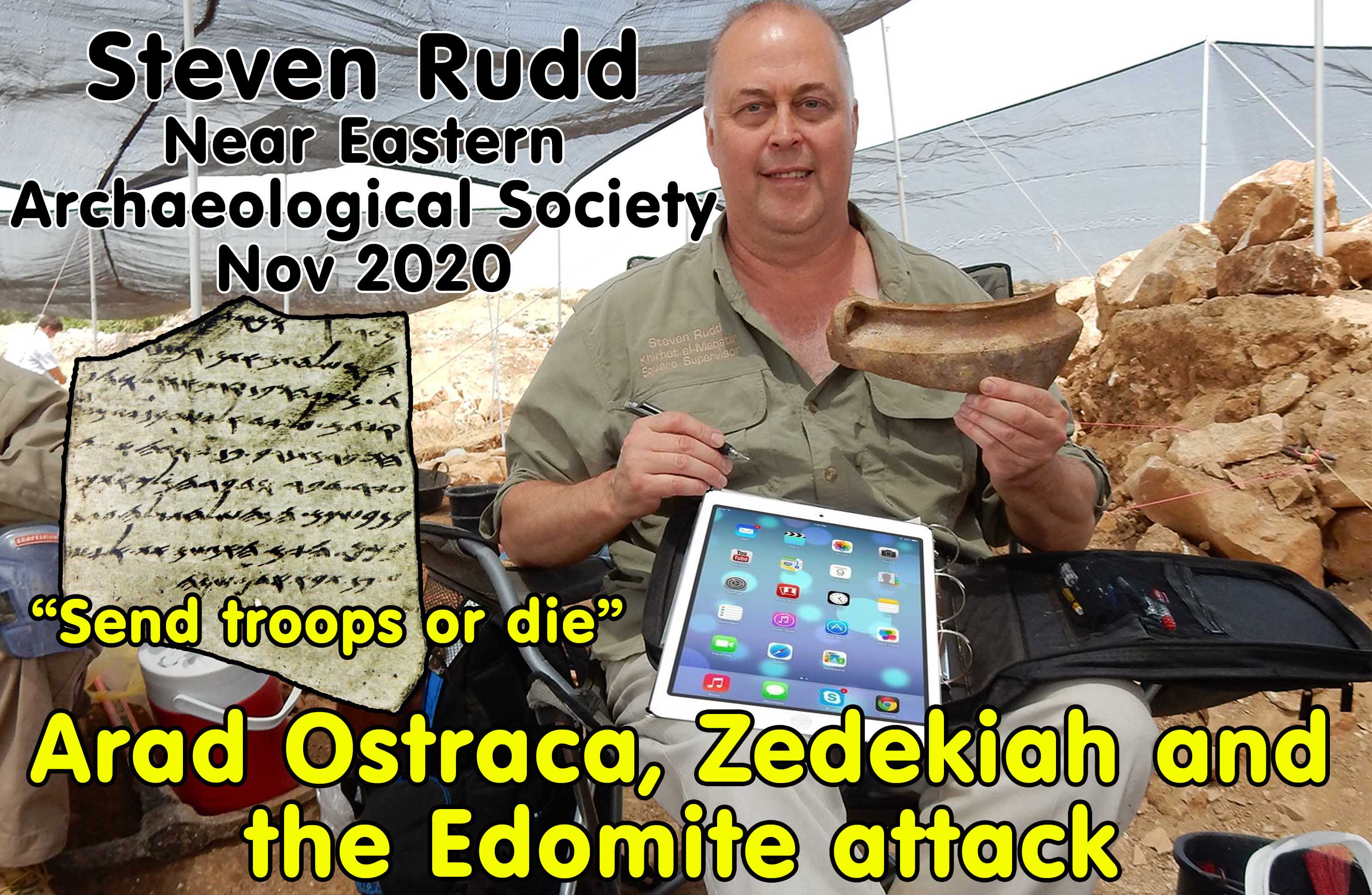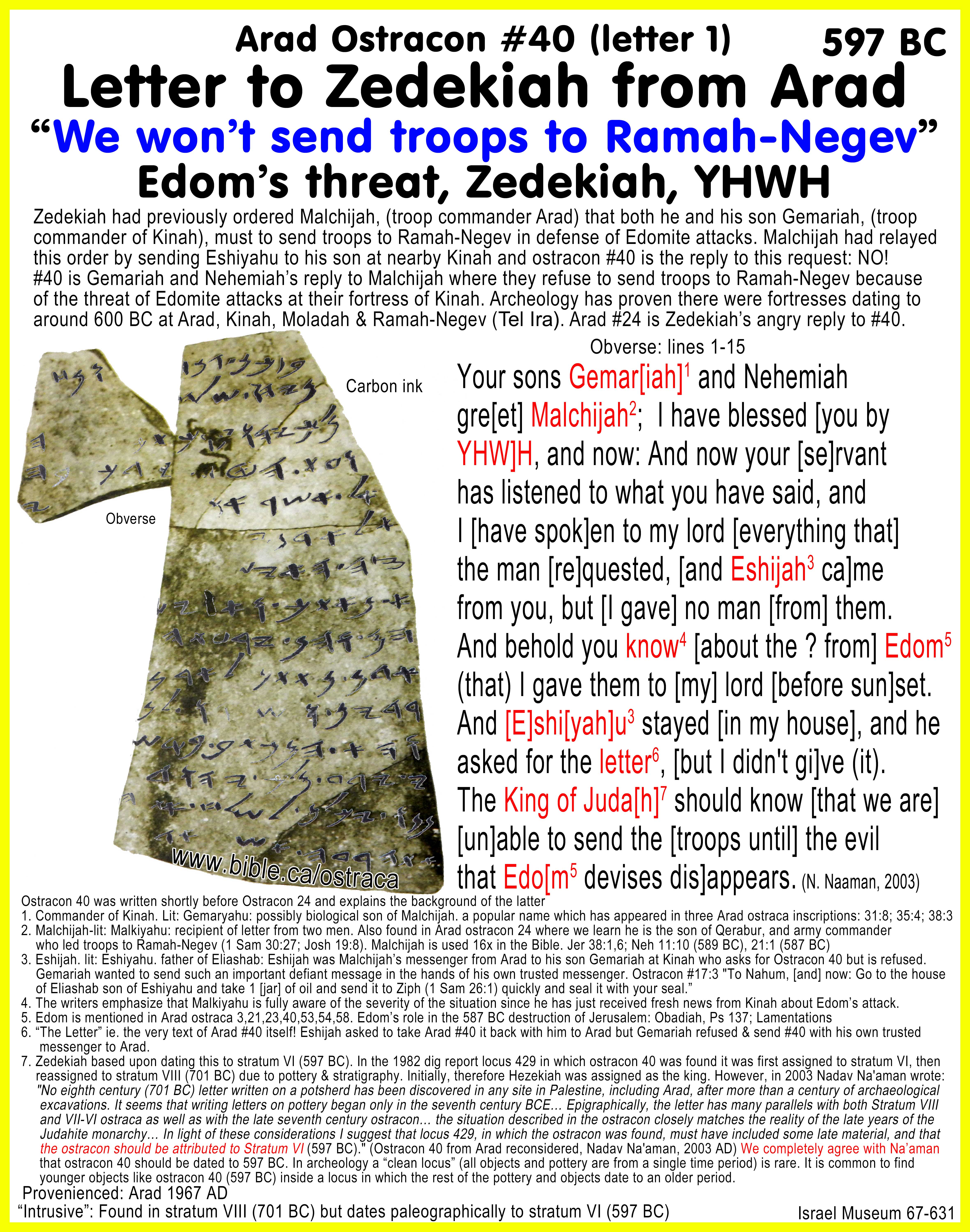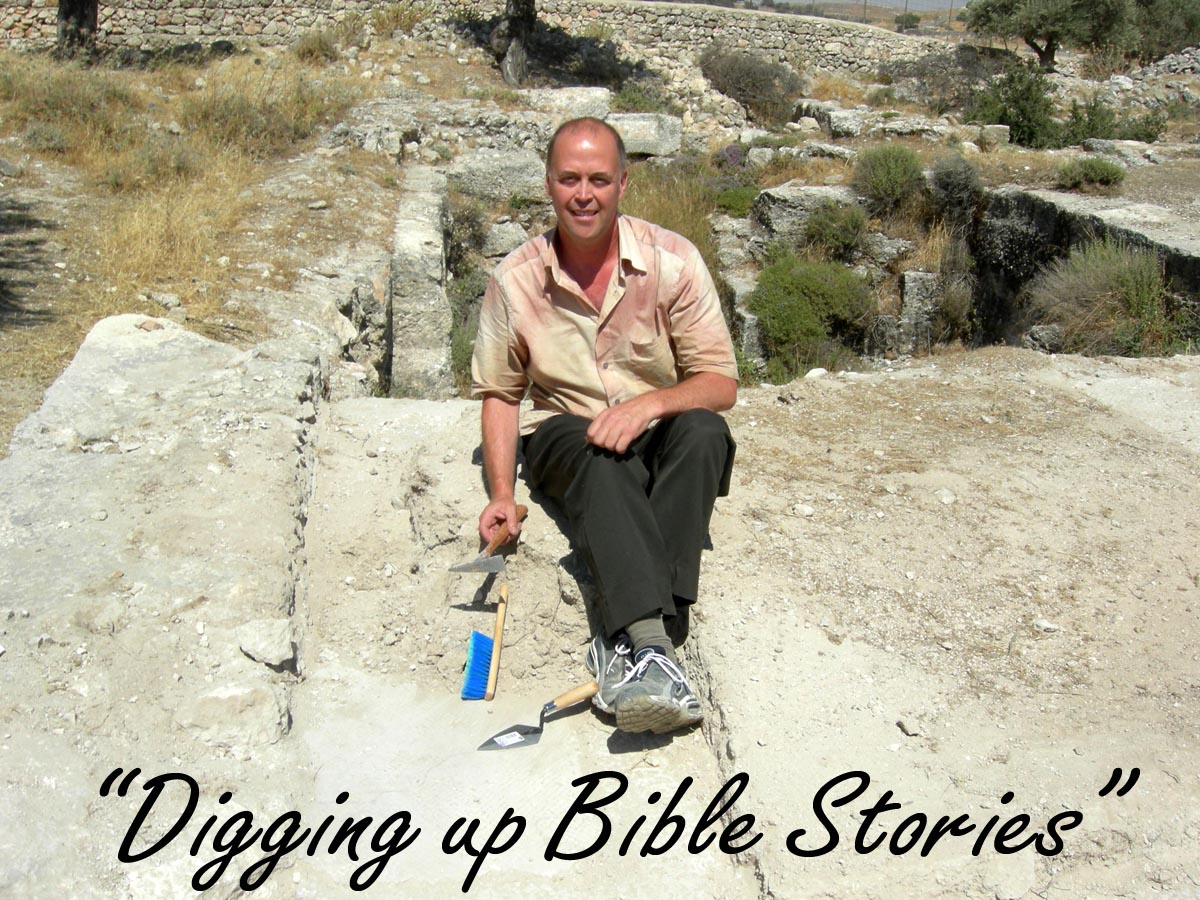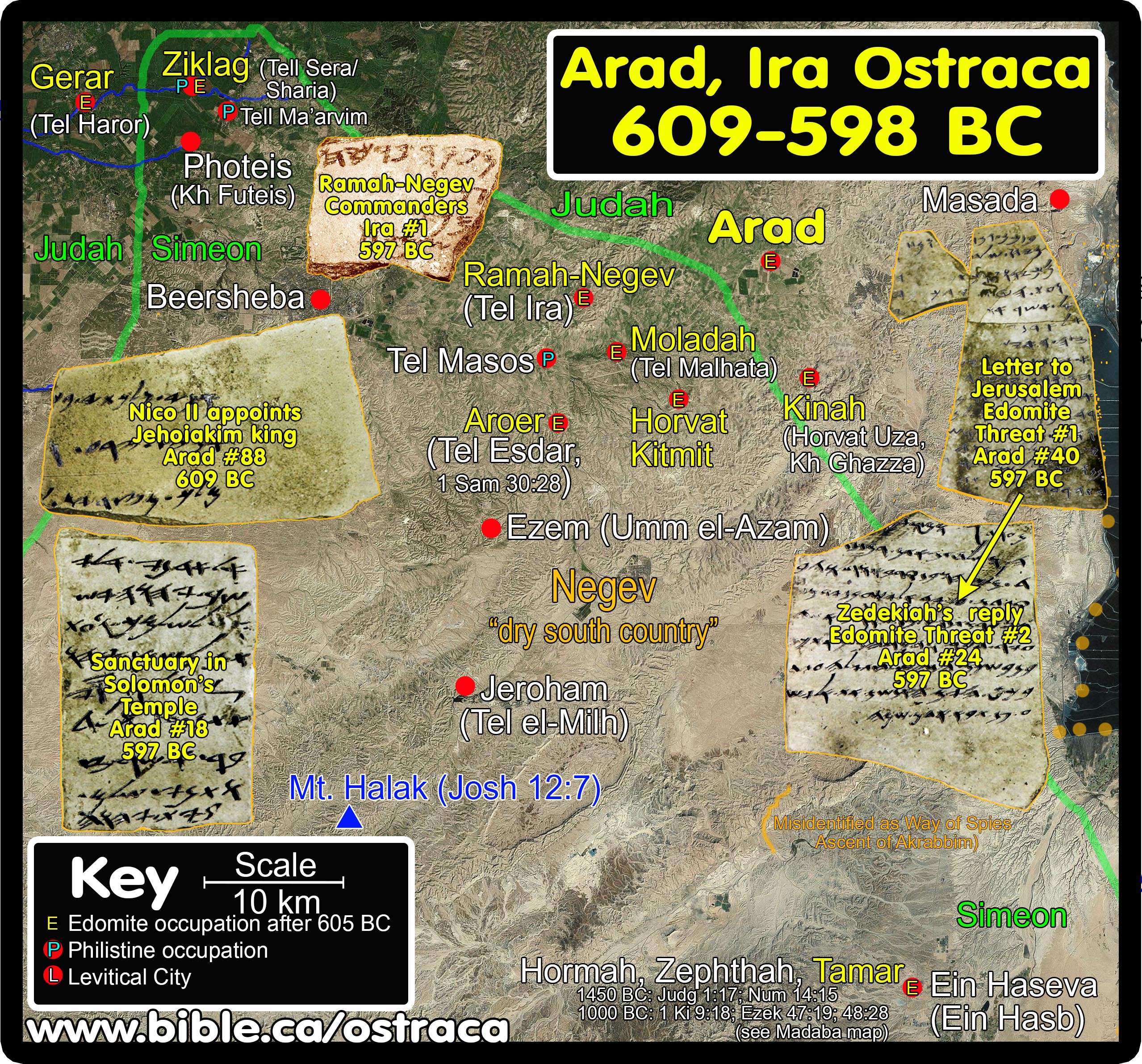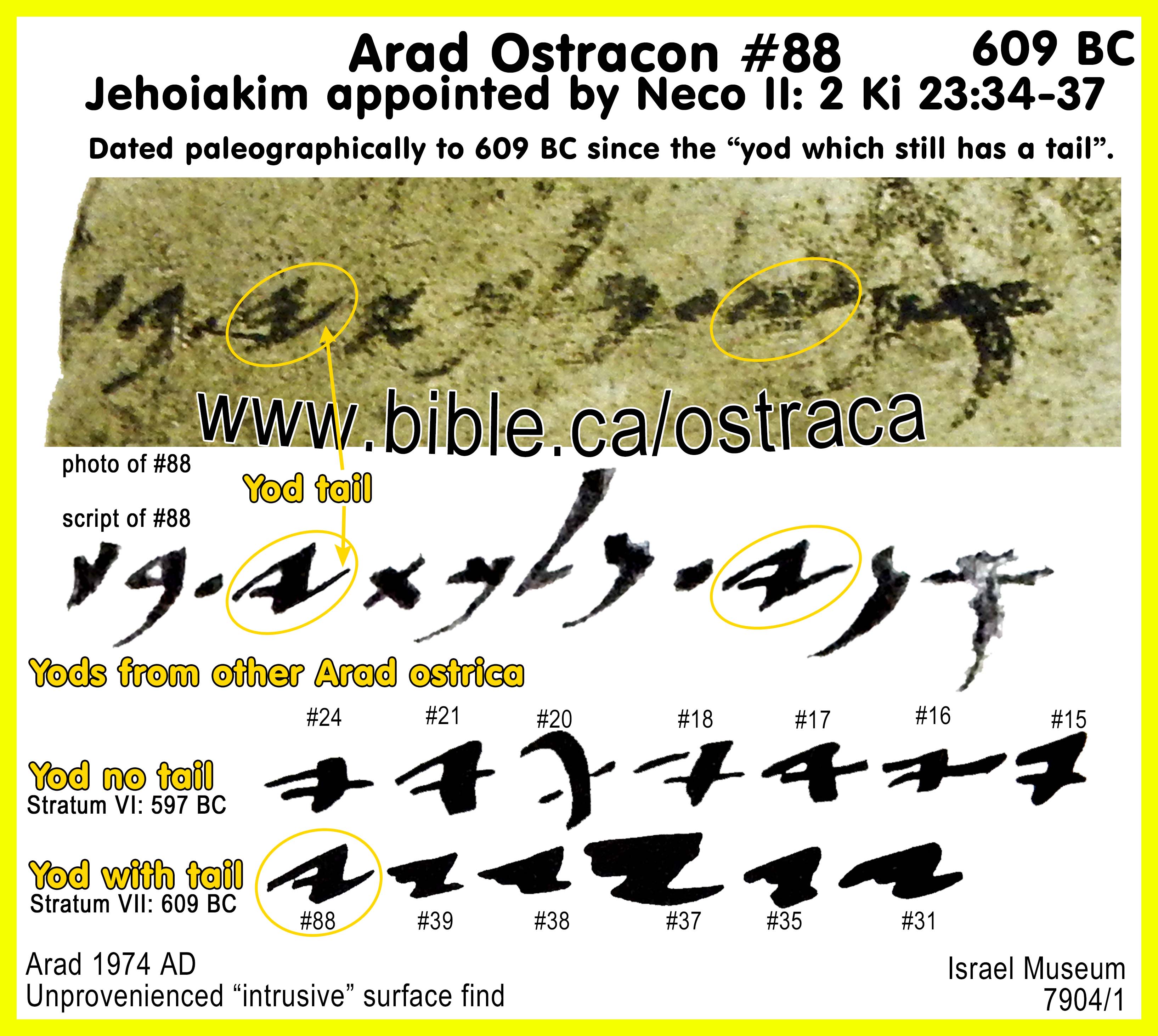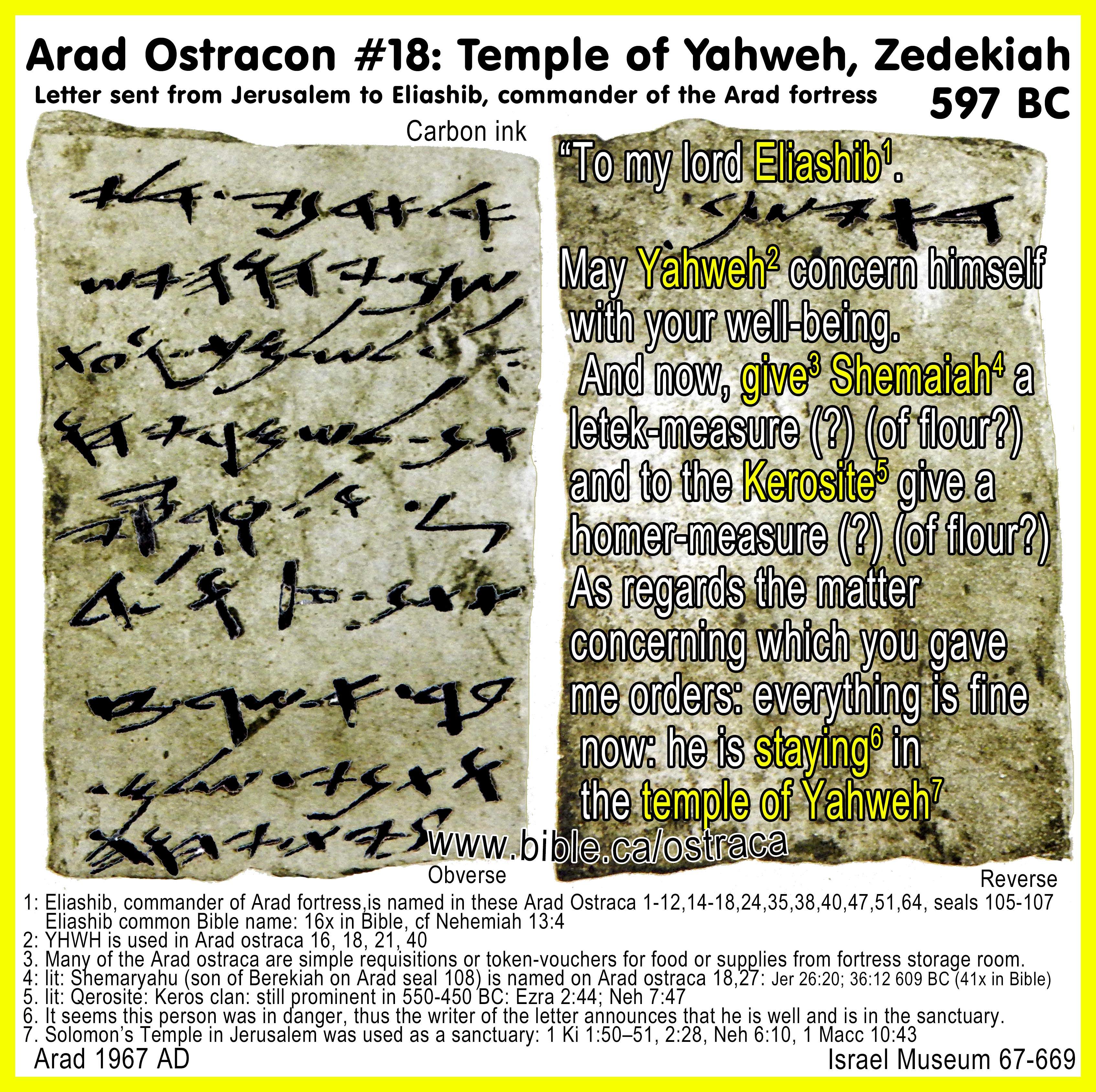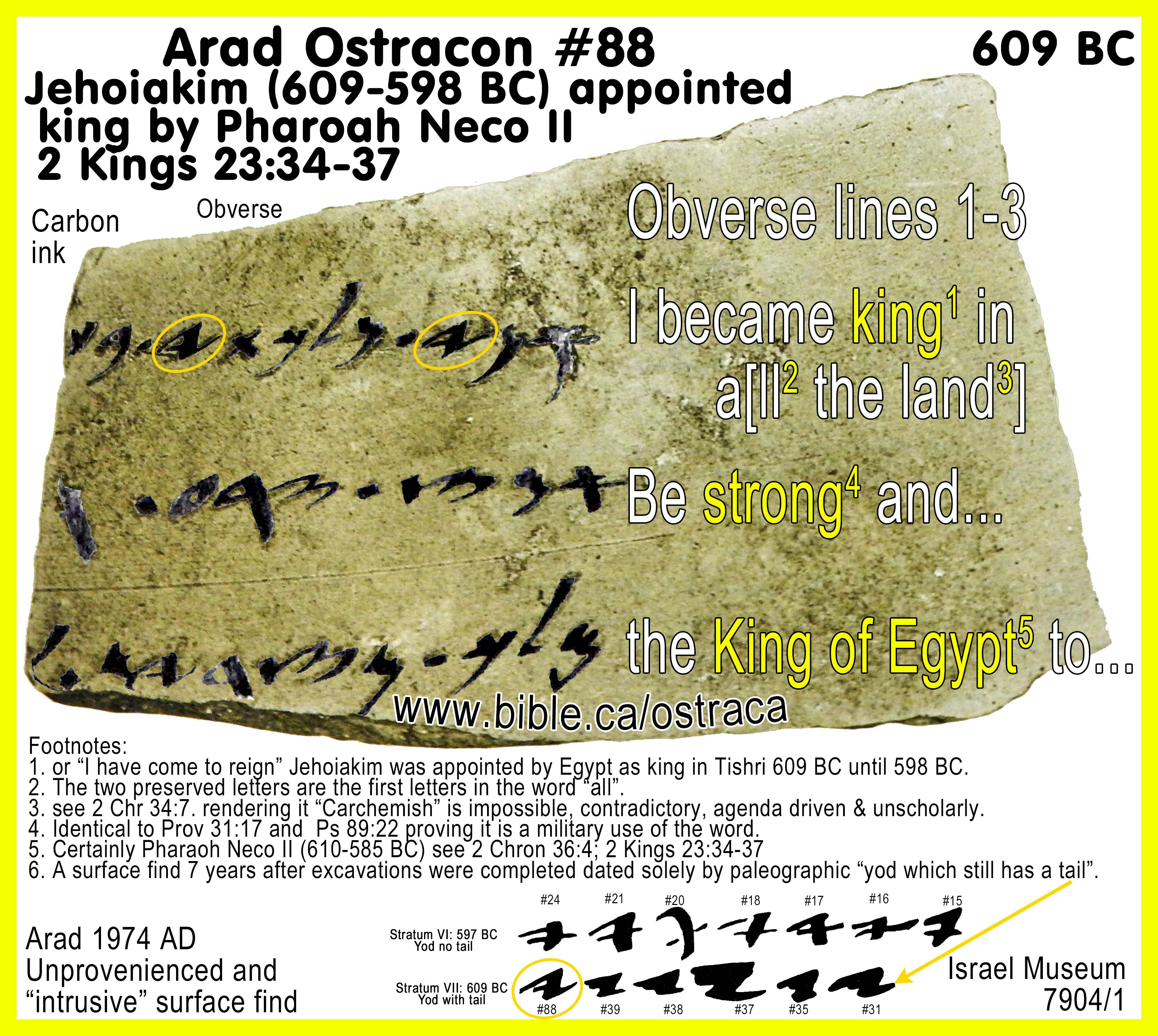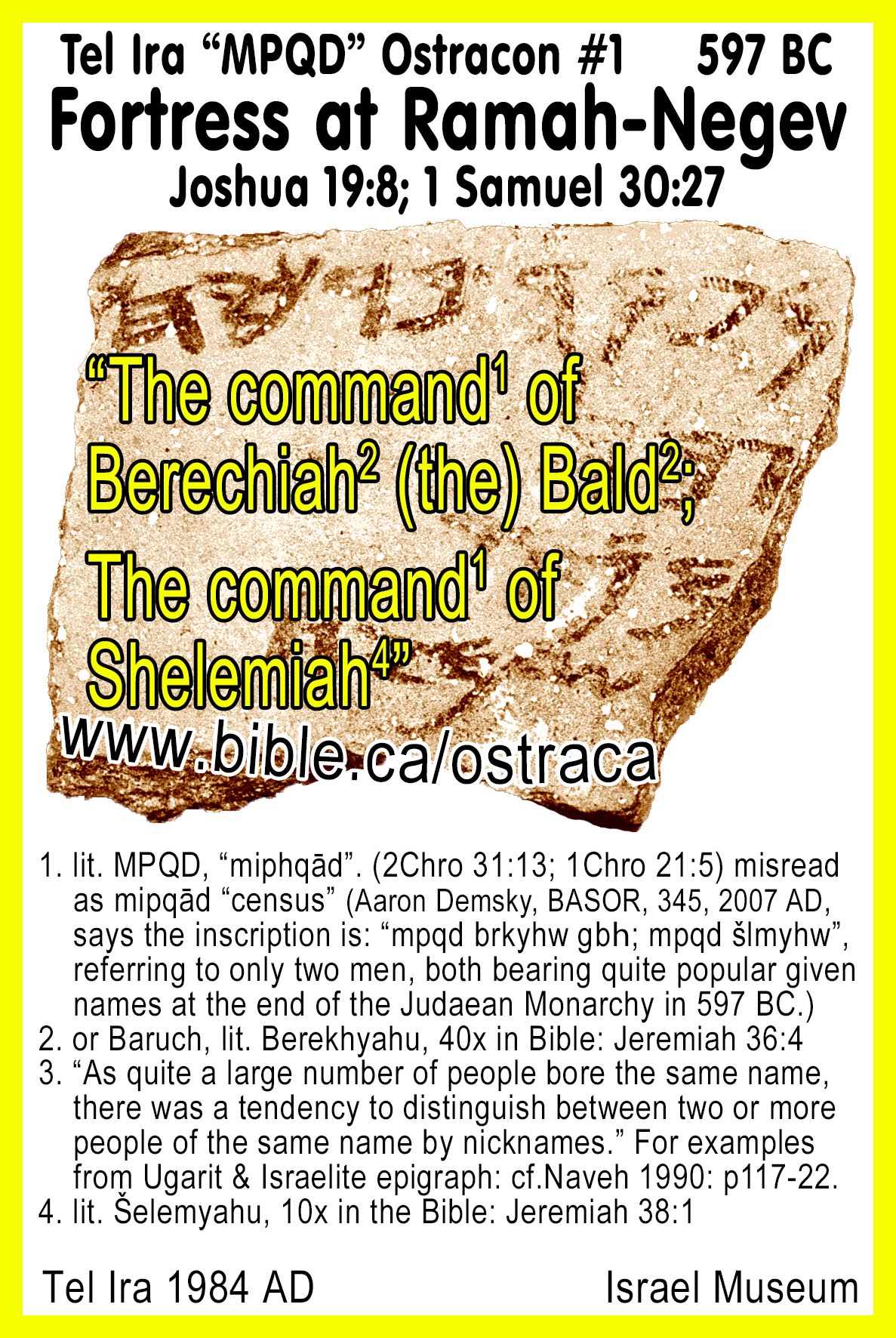Arad Ostraca #40 (597 BC) Zedekiah and the Edomite invasion into Judah
Letter 1 from Kinah to Arad and Zedekiah: We won't sent troops to Ramah Negev!
Ostraca, Tablets and Inscriptions of the Bible
Letter
1: Arad
Ostracon #40 Letter to Zedekiah: "We won't send troops" 597 BC (this page)
Letter 2: Arad
Ostracon #24 Letter from Zedekiah: "Send troops or be executed" 597
BC
|
Video: Arad Ostraca, Zedekiah, and the Edomite attack in 597 BC Steven Rudd Near Eastern Archaeological Society (NEAS) lecture November 2020 |
The amazing story told in Arad ostraca 40 and 24:
|
Letter 1: Arad Ostracon #40 Letter to Zedekiah: "We won't send troops" |
Letter 2: Arad Ostracon #24 Letter from Zedekiah: "Send troops or be executed" |
The story told by Ostraca #40 and 24:
1. Edomite history: At age 30, Esau moves from Judah to Seir, conquers the Horites in 1926 BC and begins to occupy their historic Transjordan territory east of the Arabah valley in the highlands of modern Jordan. During the time of the Exodus 1446 BC, Edom's territory ran beside Kadesh Barnea at Nabatean Petra from the gulf of Aqaba north to the Wadi Zered at the south end of the Salt Sea. After continuously occupying their historic Transjordan lands for 1321 years, they began to move west into the Judean Negev, for the first time, after Nebuchadnezzar's first attack on Jerusalem in 605 BC. By 597 BC the Edomite Threat became very serious when one of the four Negev Judean fortresses, Ramah-Negev, was about to be captured by the Edomites. See also Edomite history
2. Letter 1: Zedekiah issues orders to Malchijah, the troop commander at the Arad fortress, to send 50 troops from Arad and 50 troops from the nearby Kinah fortress, to the fortress at Ramah-Negev to secure its safety and defense. We do not have this letter but know is exists based upon Ostracon #40
3. Letter 2: Malchijah, the commander of Arad fortress, relays Zedekiah’s instructions, by sending a messenger named Eshijah, to his son Gemariah, who is the commander of the Kinah fortress, with orders to send 50 troops to defend the Ramah-Negev fortress from the Edomites. Eshijah the messenger asks to read the letter he had brought, after but Gemariah refused to let him read the private correspondence between the two fortress commanders. We do not have this letter but know is exists based upon Ostracon #40
4. Letter 3: Arad Ostracon #40: Ostracon #40 is a reply to letter #2. Gemariah, the commander of the Kinah fortress, replies on Ostracon #40 to his father, Malchijah, the commander of the Arad fortress that he will not send reinforcement troops to Ramah-Negev in defense of the Edomite attack. Gemariah, therefore disobeyed both his father at Arad and King Zedekaih in Jerusalem. Ostaracon #40 reads, "No, we will not send any of our troops to Ramah-Negev as directed by the king." The reason was because moving the troops out of Kinah to nearby Ramah-Negev would seriously endanger the security of Kinah itself against the Edomites! There were simply not enough troops to secure both fortresses at Kinah AND Ramah-Negev. See: Arad Ostracon #40 Letter to Zedekiah: "We won't send troops" 597 BC
5. Letter 4: When Malchijah, the commander at Arad, got the message from his son, who was the commander at Kinah, he apparently agreed with the danger Kinah would face if Zedekiah's order to move troops was obeyed. Malchijah, the commander of Arad then wrote king Zedekiah informing him that neither Kinah or Arad would be sending troops to Ramah-Negev. We do not have this letter but know is exists based upon Ostracon #40 and Ostracon #24
6. Letter 5: Ostracon #24. Zedekiah’s reply: “send troops to the Ramah-Negev fortress or be executed”! When King Zedekiah read Malchijah's defiant reply it angered King Zedekiah recorded his threatening response in a second order to send troops on Ostracon #24. The letter was sent to Eliashib, who was the kings executive agent at the Arad fortress. Arad ostraca #24 says, “Send 50 soldiers from Arad and 100 from Kinah under the command of Malchijah from Arad, and deliver them to the command of Elisha, commander of the Ramah-Negev fortress that is under Edomite attack.” See: Arad Ostracon #24 Letter from Zedekiah: "Send troops or be executed" 597 BC
7. Result: In the end, we know from archeology, that all four fortresses were lost to the Edomites by the time Nebuchadnezzar makes his third and final attack on Jerusalem in 587 BC when Solomon's temple is destroyed. The Edomites even assisted in destroying the city and looted even the Temple itself. During the final 587 BC Babylonian attack on Judah many Jews fled for their lives and were captured and killed by the Edomites at the crossroads near the Arad, Kinah, Ramah Negev and Moladah fortresses. "To Edom: Do not stand at the fork of the road To cut down their fugitives; And do not imprison their survivors In the day of their distress." (Obadiah 10-14) Edom was condemned by God for its role in the destruction of Judah, Jerusalem and Solomon's temple in 587 BC and became an extinct nation by the time Judah returned from captivity in 536 BC. “To Edom: Like the overthrow of Sodom and Gomorrah with its neighbors,” says the Lord, “no one will live there, nor will a son of man reside in it." (Jeremiah 49:16-18)" (Steve Rudd, 2015 AD)
|
Digging up Bible stories! 5 ostraca document 3 important Bible events: 1. Pharaoh Nico II appoints Jehoiakim king of Judah in 609 BC. 2. Edomites move into the Judean Negev and Zedekiah orders troops for defense. 3. A man seeks asylum in the temple of Solomon. See also: Outline on Josiah King of Judah (640-609 BC) Outline on Jehoiakim king of Judah (609-598 BC) Outline on Zedekiah King of Judah (597-587 BC) Outline on Gedaliah 1st Governor of Judah (587 BC) "What we read in the book, we find in the ground" |
Click here for SPECIAL INTRODUCTION TO ALL ARAD OSTRACA
|
|
|
Arad Ostracon #40: Zedekiah and the Edomite invasion into Judah |
|
|
Introduction to Arad ostracon #40: 597 BC "King Zedekiah"
- Read first to understand Arad ostracon #40 better: Archeological introduction to Arad Ostraca
- Translation of Arad ostracon #40:
- "Your sons Gemar[iah]1 and Nehemiah gre[et] Malchijah2; I have blessed [you by YHW]H, and now: And now your [se]rvant has listened to what you have said, and I [have spok]en to my lord [everything that] the man [re]quested, [and Eshijah3 ca]me from you, but [I gave] no man [from] them. And behold you know4 [about the ? from] Edom5 (that) I gave them to [my] lord [before sun]set. And [E]shi[yah]u3 stayed [in my house], and he asked for the letter, [but I didn't gi]ve (it). The King of Juda[h]6 should know [that we are] [un]able to send the [troops until] the evil that Edo[m5 devises dis]appears. (Steve Rudd adapted from Naaman and Aharoni, 2015 AD)
- For red footnotes see below.
- Brackets […] indicate missing, damaged or unreadable text.
- 5 letters: A Snapshot of the storyline reconstructed from the two ostraca letters #40 and #24:
a. Letter 1: Zedekiah sends a letter from Jerusalem to the Arad commander to send 50 troops from Arad and 50 troops from the nearby Kinah fortress to reinforce the Ramah-Negev fortress which is under attack by the Edomites.
b. Letter 2: The Arad commander sends a letter to his son, the commander at Kinah.
c. Letter 3: Ostracon #40 is the Kinah commander’s reply to his father at Arad refusing to obey Zedekiah’s request.
d. Letter 4: The Arad commander sends a reply back to Zedekiah in Jerusalem that neither Arad or Kinah will send troops to defend Ramah-Negev against the Edomites.
e. Letter 5: Ostracon #24 Zedekiah replies to the two fortress commanders: “Send the troops or be executed”.
- The story in Arad ostraca 40: (refer to map for place locations)
- Prior to the writing of Arad #40 "Letter to Zedekiah", Zedekiah had previously ordered Malchijah, (troop commander Arad) that both he and his son Gemariah, (troop commander of Kinah), must to send troops to Ramah-Negev in defense of Edomite attacks. Malchijah had relayed this order by sending Eshiyahu to his son at nearby Kinah and ostracon #40 is the reply to this request: NO! (Steven Rudd, 2015 AD)
- "Malchijah's defiant recorded in Arad #40 (Arad #40 "Letter to Zedekiah") not to send troops as commanded by Zedekiah to Ramah-Negev angered the king. King Zedekiah recorded his threatening response in a follow-up letter on another pottery sherd to Eliashib, the kings executive agent at the Arad fortress on Arad ostraca #24 (Arad Ostracon #24 Letter from Zedekiah: "Send troops or be executed" 597 BC). Zedekiah's follow-up letter to Eliashib on Arad ostraca #24 was simple: Send 50 soldiers from Arad and 100 from Kinah under the command of Malchijah from Arad, and deliver them to the command of Elisha, commander of the Ramah-Negev fortress that is under Edomite attack." (Steve Rudd, 2015 AD)
- "5 men from Arad and 5 men from Kinah must assemble at Moladah, and Malkiyahu, an officer who was probably responsible for the military forces in the eastern Negev, will lead them from this place to Ramah-Negev and turn them over to Elisha son of Jeremiah, the fort's commander. The emergency is due to an impending Edomite attack on Ramah-Negev (line 20: "lest Edom comes there"). … The troops from Arad and Kinah must have assembled at Moladah (Tel Malhata), which is located in the juncture of the two places, on the main road leading to nearby Ramah-Negeb." (Ostracon 40 from Arad reconsidered, Nadav na'aman, 2003 AD)
- Arad #40 "Letter to Zedekiah", is Gemariah and Nehemiah’s reply to Malchijah in Jerusalem where they refuse to send troops to Ramah-Negev because of the threat of Edomite attacks at their fortress of Kinah. Archeology has proven there were fortresses dating to around 600 BC at Arad, Kinah (Horvat Uza) and Ramah-Negev (Tel Ira). (Steven Rudd, 2015 AD)
- Arad ostraca #24 is Zedekiah's angry reply to Arad #40 "Letter to Zedekiah", after they refuse to send troops. (Steven Rudd, 2015 AD)
- In Arad ostraca #24 : Zedekiah commands them: "SEND THE TROOPS OR BE EXECUTED!"
- Read the second letter where Zedekiah commands to
"send troops or die" on Arad ostraca 24: Arad
ostraca #24
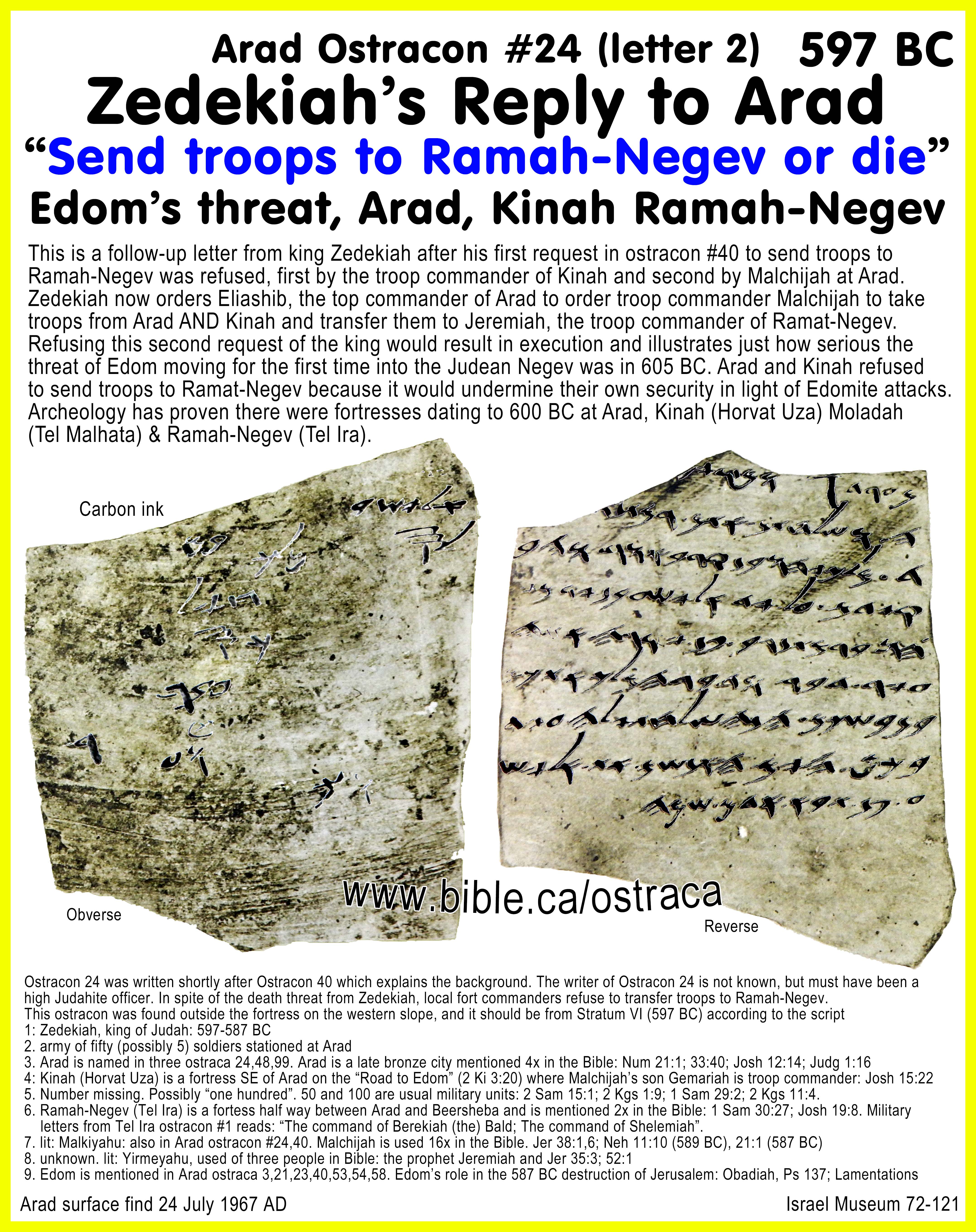
- Arad ostraca letter #40 was written first and letter #24 is the reply!
- "In my opinion, Ostracon 40 was written shortly before Ostracon 24 and explains the background of the latter. The writer of Ostracon 24 is not known, but must have been a high Judahite officer. In light of the refusal of local fort commanders to transfer troops to other places, a strict order —whose violation could incur the death penalty — is declared. … Ostraca 24 and 40 reflect the state of emergency in the Negeb of Judah in the last years of the kingdom of Judah. The Edomite danger looked so threatening that fort commanders dared refusing the instructions of their superiors to transfer soldiers located in their place to other locations, and the high command found it necessary to issue strict orders, threatening the disobeyer with death penalty, in order to get their commands fulfilled. The number of soldiers in each place must have been small and the problem of manpower severe, and local commanders, though being aware of the danger to their place, were unable to comprehend the overall picture. Under these circumstances, the high command found it necessary to impose its authority and enforce the local officers to obey its orders." (Ostracon 40 from Arad reconsidered, Nadav na'aman, 2003 AD)
- "The writer emphasizes his fidelity and his strict adherence to the orders he received. In a previous letter, he had already informed Malkiyahu of what a certain man wanted of him. He points out that he sent the letters (?) to Malkiyahu on the same day that he received them from Edom. These letters probably contained threats or unpleasant information. He tells him that Eshiyahu (the same person who came to him from Arad?) slept at his house and asked to see the letter, but was refused — probably according to instructions from Malkiyahu. Finally, he requested that the King of Judah be told that they cannot send the requested article because of some evil that Edom effected." (Arad Inscriptions, Yohanan Aharoni, Arad inscription 40, p 70, 1981 AD)
- "The background of the letter is a request by Eshyahu, possibly a royal messenger, to transfer the troops stationed with Gemaryahu and Nehemyahu, to another place. He had already met them (lines 6-7), and his request was discussed verbally between Malkiyahu and the writers (lines 4-6). Eshyahu also met Malkiyahu, and arrived, probably for a second time, at the writers' place. In the ostracon they restate their position in the debate. Firstly, they make it clear that they refused Eshyahu's request to transfer troops (lines 8-9). They add that Malkiyahu must be aware of the severity of the situation, as he has recently received updated news from Edom (lines 9-11). He must therefore support their refusal to transfer the troops from their place. Secondly, they report that Eshyahu is still in their place and ask for the letter from Edom. Finally, they make a bold statement, which Malkiyahu should relate to the king of Judah: There is a serious Edomite threat against their place, possibly Qinah (Herbal- `Oza), a fort located in the easternmost side of the Beer-sheba Valley (see below), and as long as it continues it would be impossible to move the troops to another location." (Ostracon 40 from Arad reconsidered, Nadav na'aman, 2003 AD)
- "Even though not all of the completions enjoy the same degree of certainty, the contents of the letter are clear on the whole. Gemaryahu and Nehemyahu assert that they are obedient to their superior, Malkiyahu, the commander of Arad at this time. It appears that Gemaryahu is the commander of one of the fortresses to the south of Arad, perhaps Ramah-Negeb mentioned in Inscription 24 as the first station on the border with Edom." (Arad Inscriptions, Yohanan Aharoni, Arad inscription 40, p 70, 1981 AD)
I. Mapping the surrounding cities: Arad, Kinah, Moladah and Ramah-Negev
- The story on the two Arad ostraca (40, 24) involved 4 city fortresses in 597 BC:
- Arad: a major fortress in command over two other fortresses: Ramah-Negev
- Kinah located 10 km south of Arad (Horvat Uza, Khirbet Ghazza)
- Moladah (Tel Malhata) located 10 km south west of Arad.
- Ramah-Negev, (ie. high place of the desert) 10 km west of Arad. (Tel Ira)
- Archeology has proven there were fortresses dating to around 600 BC at Arad, Kinah (Horvat Uza) and Ramah-Negev (Tel Ira) and Moladah (Tel Malhata)
|
"5 men from Arad and 5 men from Qinah [Kinah] must assemble at Moladah, and Malkiyahu, an officer who was probably responsible for the military forces in the eastern Negev, will lead them from this place to Ramah-Negev and turn them over to Elisha son of Jeremiah, the fort's commander. The emergency is due to an impending Edomite attack on Ramah-Negev (line 20: "lest Edom comes there"). Lemaire identified Qinah at Horvat Uza (Khirbet Ghazza) and Ramah-Negeb at Tel Ira, and his suggested identifications were accepted by other scholars. Tel Malhata is identified with Malatha, an Idumean fortress in the late Second Temple period and later a fort garrisoned. Although the names Moladah and Malatha/Moleatha are etymologically different, in light of the similarity of the topographical data and the sound of names, Abel suggested identifying Moladah at Tel Malhata. In my opinion, Abel's suggested identification for Tel Malhata is the best so far, and, if correct, corresponds with my restoration of Ostracon 24:12. The troops from Arad and Qinah must have assembled at Moladah (Tel Malhata), which is located in the juncture of the two places, on the main road leading to nearby Ramah-Negeb (Tel `Ira'). For the excavations of Tel Malhata, see Kochavi 1993, with earlier literature; Eldar and Baumgarten 1993; Beit-Arieh 1998." (Ostracon 40 from Arad reconsidered, Nadav na'aman, 2003 AD) |
II. Edom's role in the destruction of Solomon's temple in 587 BC:
- The Edomite Threat: 605 - 587 BC
- Arad ostraca inscription number 40 and Arad ostraca inscription number 24 are an amazing window into the world of Zedekiah in 597 BC and the encroachment of Edom into the Judean Negev for the first time in history.
- Arad ostraca 40 and 24 illustrate the serious Edomite threat in the Judean Negev to Zedekiah in 597 BC, when local fort commanders disobeyed, under threat of death, a strict order of King Zedekiah. Arad ostraca #40 was written first and #24 is the reply.
- The two ostraca [Arad inscription 40 and inscription 24] illustrate the state of emergency in the Negeb of Judah in the last years of the kingdom of Judah, when the high command found it difficult to impose its authority on the local fort commanders and was obliged to issue strict orders and even threaten them with the death penalty for its commands to be obeyed." (Ostracon 40 from Arad reconsidered, Nadav na'aman, 2003 AD)
- This is important because it proves Kadesh Barnea CANNOT be located at Ein Qudeirat in the Sinai, but rather at Petra.
- Kadesh Barnea is located ON THE BORDER with Edom and because Edom was never anywhere near Quderat (see map below) in 1406 BC this forces Kadesh into modern Jordan.
- Only after 605 BC did Edom, for the first time in history, move into the Judean Negev.
- See outline
on Edom and more information below.
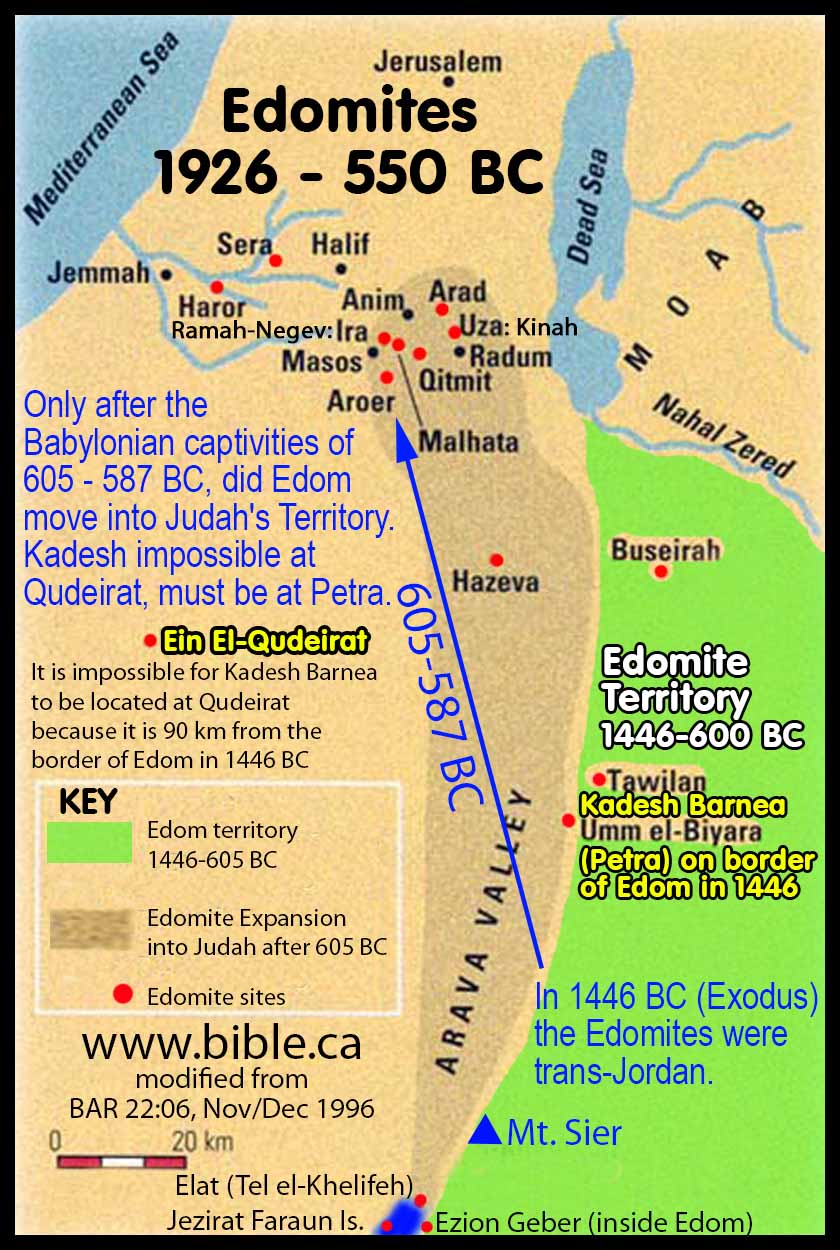
- The current location of Kadesh Barnea in every almost
Bible map today is wrong. Take note that before 1916 AD, most Bible
scholars located Kadesh Barnea either at Petra or nearby.
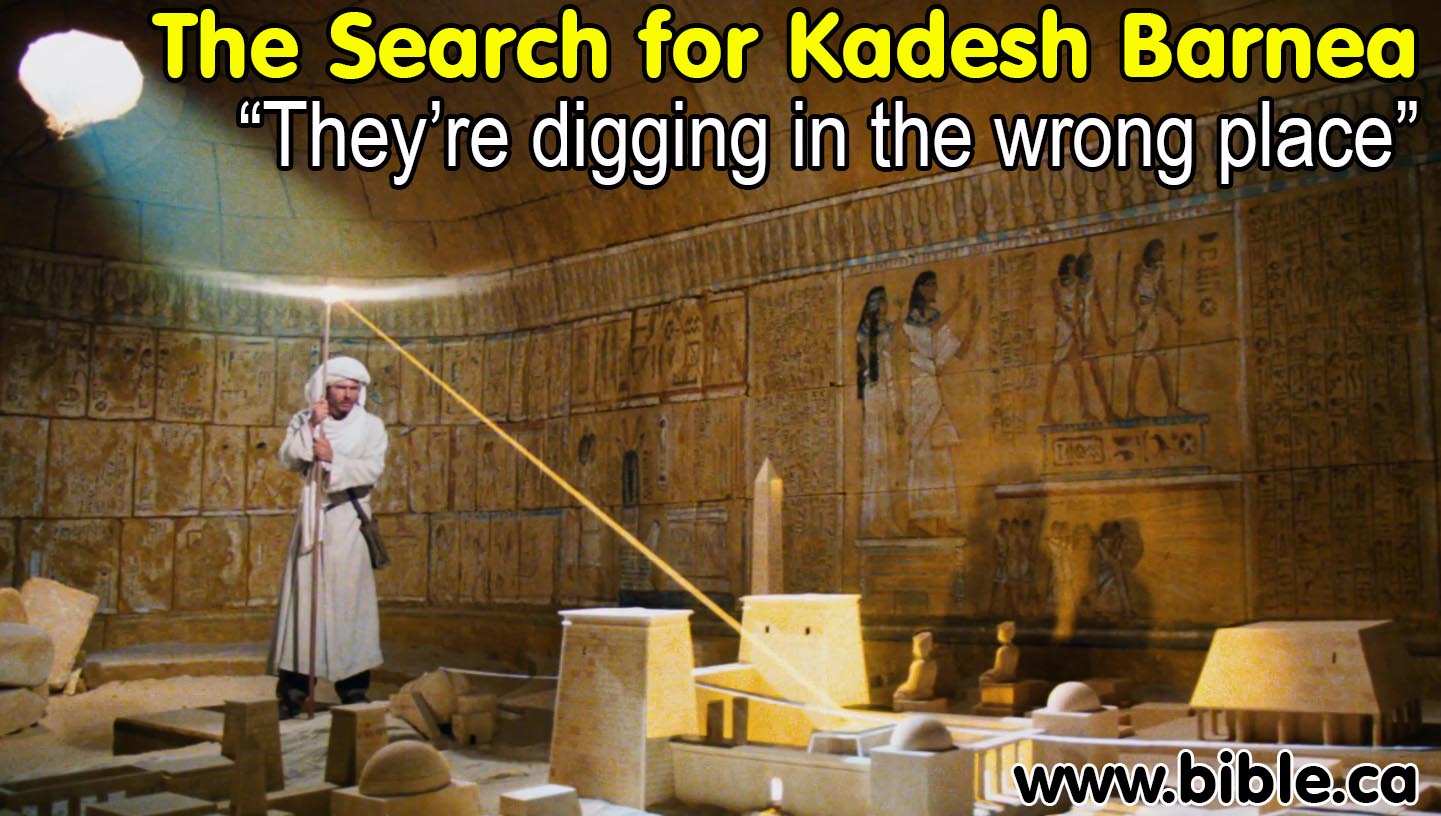
- Condemnation for Edom for its role in the 587 BC destruction of Judah and Temple: Obadiah 10-14, Ps. 137:7; Lam. 4:21; Ezek. 25:12-14; 32:29; 35:1-15. 1 Esdras 4:45. Jer 27:1-3; 49:13, 16-18.
- "the day of Jerusalem’s fall, how Edom said, “Tear it down! Tear it down! Down to its foundations!”" (Psalm 137:7)
- "Edom acted revengefully against the house of Judah" (Ezekiel 25:12–14)
- "Edom cherished an ancient enmity, and gave Israel to the power of the sword at the time of their calamity, at the time of their final punishment" (Ezekiel 35:5)
- "Edom said, ‘These two nations [Israel and Judah] and these two lands will be mine, and we will possess them'" (Ezekiel 35:10)
- "“As you rejoiced over Israel because it was desolate" (Ezekiel 35:15)
- "“Because of violence to your brother Jacob, on the day that you stood aloof, on the day that strangers carried off his wealth, And foreigners entered his gate And cast lots for Jerusalem- You too were as one of them. “Do not gloat over your brother’s day, “Do not enter the gate of My people In the day of their disaster. And do not loot their wealth In the day of their disaster. Do not stand at the fork of the road To cut down their fugitives; And do not imprison their survivors In the day of their distress." (Obadiah 10-14)
- "Cyrus vowed to rebuild the temple which the Edomites set on fire when Judah was devastated by the Chaldeans." (1 Esdras 4:45)
- Edom will become an extinct nation:
- "Bozrah will become an object of horror, a reproach, a ruin and a curse; and all its cities will become perpetual ruins.” (Jeremiah 49:13)
- "The arrogance of your (Edom's) heart has deceived you, Though you make your nest as high as an eagle’s, I will bring you down from there,” declares the Lord. “Edom will become an object of horror; everyone who passes by it will be horrified and will hiss at all its wounds. “Like the overthrow of Sodom and Gomorrah with its neighbors,” says the Lord, “no one will live there, nor will a son of man reside in it." (Jeremiah 49:16–18)
- The Nabateans who rebuilt tomb city of Kadesh Barnea occupied by Moses during the exodus (1444-1407 BC) into the Petra we see today are a mystery.
- The Nabateans come onto the world stage for the first time about 350 BC.
- Edom went extinct about 550 BC when they were destroyed by Babylon.
- Some speculate that the Nabateans are the remnant of Edom.
- The origin of the Nabateans remains a mystery but it is certainly not Edom.
- God said that Edom would become an extinct nation and we
can see the huge boundaries of the Nabatean kingdom in 50 BC at its
greatest extent.
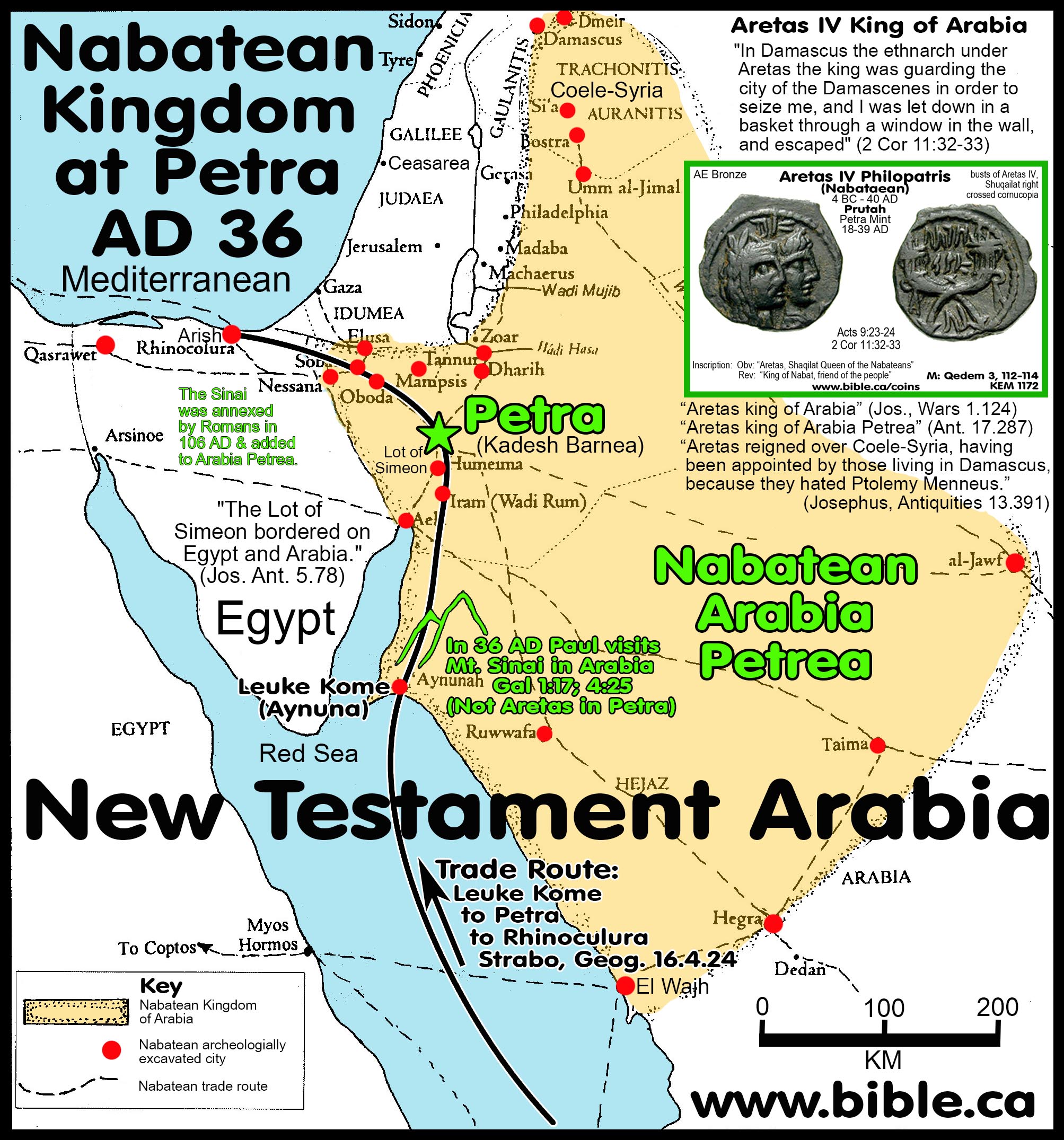
III. "Intrusive" (anachronistic) pottery and objects
- Intrusive (anachronistic) pottery and objects are dated to one time but found in a locus of a different time.
- An intrusive archeological object is a first century coin of Pilate in the center of a locus which unquestionably contains late bronze pottery.
- An intrusive archeological object a byzantine lamp in a first century locus.
- Intrusive archeological pottery is an early bronze pottery handle in a first century locus.
- Both Arad #88 "Neco II appoints Jehoiakim" and Arad #40 "Letter to Zedekiah" are "intrusive" archeological artifacts since both date to a time DIFFERENT from the locus they were found in.
- Arad #40 "Letter to Zedekiah" is intrusive, since it dates to 597 BC (stratum VI) but was found inside stratum VIII which dates to 701 BC.
i. Even if it was professionally unearthed in the middle of a well documented archeological locus, (which it wasn't) this is no guarantee that the object's date matches the known date of the locus.
ii. A "clean locus" (ie. all pottery and objects within a single locus is from a single time period) does happen, but is uncommon in professional digs.
- Arad #88 "Neco II appoints Jehoiakim" is intrusive because it clearly dated to 609 BC but was found on the surface which would generally date hundreds or thousands of years younger.
- What causes "intrusive" artifacts?
- Why are "intrusive" artifacts from one time period, professionally excavated from a locus or stratum of a different time period? It is VERY common for archeological excavations to identify intrusive (anachronistic) objects and pottery. Archeologists EXPECT to find intrusive artifacts in every dig.
- Looting: Both ancient and modern looters created intrusive artifacts because the oldest dirt at the bottom ends up on top of the youngest dirt as they dig down from the surface. Archeologists routinely identify "inverted stratum" because of looting. This creates a "tumbled locus".
- Geological events: Earthquakes, floods, wind storms etc can cut crevices into the surface that allow younger materials to fall down to older levels of dirt. Over time the crevice is filled in with new dirt or the crevice collapses into itself. Floods can also wash older buried materials out onto the surface. Wind storms can strip away younger layers, leaving older layers near the surface then blow them out of context to a new location where they are buried.
- Agricultural: Farmers will dig out an area, remove stones and redeposit the soil to a new location then plant crops or trees. This creates a "tumbled locus".
- Manmade pits: There are many reasons why pits and holes will be dug at a location which allows a mixing of loci and intrusive artifacts.
- Burrowing animals: It is well documented by the IAA (Israeli Archeological Authority) that gophers will dig two meters down to bedrock and take with them coins which become intrusive finds for archeologists. At Khirbet el Maqatir, I have found first century coins (ER) in an Hasmonean (LH) locus (175 BC) and modern coins in Early Roman (ER) locus (30 AD). I have excavated squares at Khirbet el Maqatir where Gophers love to drag modern surface garbage (plastics, Coke bottle caps etc;) down to their nesting area in a locus that dates to Late Bronze (1450 BC) or First century (Early Roman).
IV. Reassigning the date of Arad ostracon #40 to 597 BC:
- Arad #40 "Letter to Zedekiah" is "intrusive", since it dates to 597 BC (stratum VI) but was found inside stratum VIII which dates to 701 BC.
- Arad ostracon 40 should be dated to 597 BC.
- With this new date, it becomes clear that it is directly related to Arad Ostracon #24, where #40 was written first and #24 was the reply to #40.
- Originally, this ostracon was wrongly dated to 701 BC, coinciding with Hezekiah and Sennacherib, king of Assyria
- This date is totally wrong for many reasons.
- "This ostracon belongs to Stratum VIII, and if our chronology is correct, then the King of Judah mentioned is Hezekiah. [If that be the case, then perhaps the evil done by Edom was their early capitulation to Sennacherib on the eve of the latter's campaign against Judah and Philistia. AFR]" (Arad Inscriptions, Yohanan Aharoni, Arad inscription 40, p 70, 1981 AD)
- In 2003, Nadav na'aman corrected the date for Arad ostracon #40 to 597 BC:
- "This article suggests a new date, transliteration and translation for Ostracon 40 from Arad. In light of the date and textual analysis, a reconstruction of the historical situation reflected in the text is offered and the information gained from Ostracon 40 is combined with that of Ostracon 24. The two ostraca illustrate the state of emergency in the Negeb of Judah in the last years of the kingdom of Judah, when the high command found it difficult to impose its authority on the local fort commanders and was obliged to issue strict orders and even threaten them with the death penalty for its commands to be obeyed." (Ostracon 40 from Arad reconsidered, Nadav na'aman, 2003 AD)
- "In the publication of the ostracon Aharoni noted that he first associated the locus in which the ostracon was found with Stratum VII, but, as the excavation continued it became clear that it belongs to Stratum VIII". Stratigraphic considerations and the ceramic evidence indicate that the ostracon should be assigned to Stratum VIII (Aharoni 1970: 29, n. 39; 1981: 74, n. 1). However, no eighth century letter written on a potsherd has been discovered in any site in Palestine, including Arad, after more than a century of archaeological excavations. It seems that writing letters on pottery began only in the seventh century BCE. Moreover, the orthography indicates a relatively late date, with internal moires lectionis for 'y.3' (lines 7-8) and yhwd[h] (line 13). Epigraphically, the letter has many parallels with both Stratum VIII and VII-VI ostraca as well as with the late seventh century ostracon of Mead 1.1aavydlid (Pardee 1978: 323, 11. 144). Finally, the situation described in the ostracon closely matches the reality of the late years of the Judahite monarchy. In light of these considerations I suggest that locus 429, in which the ostracon was found, must have included some late material, and that the ostracon should be attributed to Stratum VI. Malkiyahu, the recipient of the letter, is possibly the officer Malkiyahu the son of Qerab'ur, who led troops to Ramah-Negeb according to Ostracon 24 from Arad." (Ostracon 40 from Arad reconsidered, Nadav na'aman, 2003 AD)
- Three stages of dating Arad Ostraca #40:
- Stage 1: Ostracon #40 was found in locus 429 which was originally assigned to Stratum VII dating to the time of Josiah (740 BC).
|
Stage 1: 1967: Initial discovery of #40 in locus 429 by Aharoni |
|||
|
Ostraca #24 |
Stratum VI |
605 - 595 BC (Jehoiakim, Zedekiah) |
22 + 10 |
|
Ostraca #40 |
Stratum VII |
7th century BC (Josiah) |
3 + 10 |
|
|
Stratum VIII |
End of 8th century BC (Hezekiah) |
18 + 4 |
- Stage 2: After further excavations, Locus 429 was reassigned to Stratum VIII dating to the time of Hezekiah (701 BC).
|
1967-2003: Redating #40 in locus 429 by Aharoni |
|||
|
Ostraca #24 |
Stratum VI |
605 - 595 BC (Jehoiakim, Zedekiah) |
22 + 10 |
|
|
Stratum VII |
7th century BC (Josiah) |
3 + 10 |
|
Ostraca #40 |
Stratum VIII |
End of 8th century BC (Hezekiah) |
18 + 4 |
- Stage 3: Ostracon #40 was redated to the time of Zedekiah (597 BC) based upon the epigraphical features and the style of letter formation of the Paleo-Hebrew script. This means that both Ostracon #40 and #24 date to the same period. Ostracon #40 was viewed as being intrusive, meaning a younger archaeological object was excavated inside a three-dimensional layer of matrix (dirt) that was older, known as a “mixed locus”. It is very common to find objects and pottery dating to many different time periods, separated by hundreds of years within a single locus. A “clean locus” means all objects and pottery dated to a single occupation period and is rare in professional excavations.
|
2003 to present: Redating #40 as intrusive to stratum VI by Na'aman |
|||
|
Ostraca #24 Ostraca #40 |
Stratum VI |
605 - 595 BC (Jehoiakim, Zedekiah) |
22 + 10 |
|
|
Stratum VII |
7th century BC (Josiah) |
3 + 10 |
|
|
Stratum VIII |
End of 8th century BC (Hezekiah) |
18 + 4 |
V. Paleographical reading of Arad ostracon #40 by Hebrew script AND content
- Ostracon #24 was a surface find and dated to 597 BC based solely on paleography (letter formation, etc.) and this has never been challenged. It is therefore not surprising that Ostracon #40 would be redated on the same paleographic basis.
- Both Arad #40 and Arad #88 were "intrusive" ostraca that are dated solely on the basis of paleographical analysis without any stratigraphical or loci considerations. This is very common in professional archeological excavations.
- Arad #40 "Letter to Zedekiah" was determined to be intrusive based upon the content of the letter and the Hebrew text.
- Arad ostracon #40, was professionally excavated and fully provenienced with detailed three-dimensional recording of where it was found in the locus but it was still clearly intrusive.
- Arad #40 "Letter to Zedekiah" is “Intrusive”: Found in stratum VIII (701 BC) but dates paleographically to stratum VI (597 BC)
- The reason it was clear that Arad #40 "Letter to Zedekiah" did not belong to stratum VIII and date to 701 BC is because of epigraphically it could be dated to either stratum but more importantly the content of the letter itself.
- Arad #88 "Neco II appoints Jehoiakim" is another example of "intrusive" pottery.
- Since Arad ostracon 88 was a valid surface provenanced find at Tel Arad, but it is technically unprovenienced since it lacks a three-dimensional record of where it was found on the site.
- In fact, no one knows where it was found on the surface at Tel Arad.
- Arad Ostraca #88 is a genuine archeological object as a surface find from Tel Arad but since it is unprovenienced, its date must be determined epigraphically and by content.
|
Paleographically, Arad #88 is a close match to 609 BC (Stratum VII): "According to the script, it is clear that it belongs to Stratum VII, and vid. especially the yod which still has a tail, but the two upper horizontal strokes make a sort of triangle in which the upper line is longer and somewhat rounded." (Arad Inscriptions, Aharoni, Arad #88)
"clearly part of a letter from the king of Judah to the fortress commander; according to the handwriting, it must come from Stratum VII. This is an important addition to the collection of ostraca." (Arad inscriptions, Joseph Yohanan Naveh, p5, 1981 AD)
|
VI. Translation of Arad
ostracon #40:
Ostracon #40 was written shortly before Ostracon #24 and explains
the background of #24
|
"Your sons Gemar[iah]1 and Nehemiah gre[et] Malchijah2; I have blessed [you by YHW]H, and now: And now your [se]rvant has listened to what you have said, and I [have spok]en to my lord [everything that] the man [re]quested, [and Eshijah3 ca]me from you, but [I gave] no man [from] them. And behold you know4 [about the ? from] Edom5 (that) I gave them to [my] lord [before sun]set. And [E]shi[yah]u3 stayed [in my house], and he asked for the letter, [but I didn't gi]ve (it). The King of Juda[h]6 should know [that we are] [un]able to send the [troops until] the evil that Edo[m5 devises dis]appears. (Steve Rudd adapted from Naaman and Aharoni) For red footnotes see below. Brackets […] indicate missing, damaged or unreadable text. |
|
|
Steve Rudd's footnotes from his adapted translation above
|
|
A. Translation notes from: Arad Inscriptions, Yohanan Aharoni, Arad inscription 40, p 70, 1981 AD
Aharoni translation: "Your son Gemar[yahu] and Nehemyahu gre[et] Malkiyahu; I have blessed [you to the Lorlci, and now: Your servant has listened to what [you] have said, and I [have written] to my lord [everything that] the man [wa]nted, [and Eshiyahu came from you, and [no] one [gave it to] them. And behold you knew [about the letters from] Edom (that) I gave to [my] lord [before sunset. And [E]shi[yah]u slept [at my house], and he asked for the letter, [but I didn't gi]ve (it). The King of Judah should know [that w]e cannot send the [..., and this is the evil that Edo[m has done]." (Arad Inscriptions, Yohanan Aharoni, Arad inscription 40, p 70, 1981 AD)
- The excavation reports for Arad Ostracon #40 are:
- Arad was excavated 1962-1967 AD.
- "Ostracon 40 from Arad was published by Y. Aharoni (1970: 28-32), and republished, with a much fuller set of restorations, in Nelson Glueck's Memorial Volume (Aharoni 1975), and in the edition of the Arad inscriptions (Aharoni 1981: 70-74). The text has been discussed in detail by some scholars, all of whom adopted Aharoni's restorations, with a few minor variations." (Ostracon 40 from Arad reconsidered, Nadav na'aman, 2003 AD)
- Arad Inscriptions, Yohanan Aharoni, Arad inscription 40, p 70, 1981 AD (The Hebrew version was published years earlier, but the English edition has many updates and corrections)
- Three Hebrew Ostraca from Arad, Y. Aharoni, BASOR 197, p 28, 1970 AD
- "The ostracon was found in a room in the center of the fortress, which was full of compartments and various installations — apparently used for the manufacture of perfume.' This is an extremely interesting text, sent apparently by the commander of a southern fortress to the main citadel at Arad. Only about two-thirds of its contents were preserved, and in the preliminary publication, I didn't attempt to complete the missing parts. In a second article, I emended my first readings in several details, and now with some new readings, it is possible to reconstruct most of the text. Some of the completions are naturally guesses, but it seems to me that in the main, the contents are clear enough from the parts which were preserved. The ostracon is whole in the upper part and on the right side. Thus the beginning of the letter and the beginnings of 15 lines are perfectly clear. The left side is missing, aside from a small section at the top which is mostly illegible. It appears that this upper left section of the letter was indeed the left-hand edge of the ostracon, since the words make sense. Thus the upper width of the letter was 66 mm., and the bottom width about 135 mm. The width of the sherd that was preserved is 31 mm. above and 88 mm. below. In the first four lines, about half of each line is missing (aside from single letters), and of the remaining lines, something more than a third of each is missing. There is another difficulty in that the sherd on which the letter was written is a dark grey fragment of a jug with black soot smudges. The black ink does not stand out on the dark background, and the letters in rows 10-12 are especially faded and defaced." (Arad Inscriptions, Yohanan Aharoni, Arad inscription 40, p 70, 1981 AD)
B. Line by line commentary: Arad Inscriptions, Yohanan Aharoni, Arad inscription 40, p 70, 1981 AD
- Line 1. Your son — There is no doubt as to the reading of this word. This opening shows that the men who wrote the letter were of inferior rank to the addressee, and for a similar opening vid. Inscription 21. As we shall see below, the addressee of the letter was one man alone, Malkiyahu, and as such the plural suffix is surprising. It would appear that Malkiyahu, similar to those who received instructions in Inscription 24, represents the authority to whom the sender is subordinate. Thus it seems that Malkiyahu was one of the senior administrators at Arad, apparently the commander (the gym, in the language of the letter from Mesad Hashavyahu). Gemaryahu — a popular name which has also appeared in three previous ostraca (Inscriptions 31:8; 35:4; 38:3). Nehemyahu — this name, too, has already appeared in Inscription 31:3. The reading, "and Nehemyahu", seems certain, and thus the letter was sent by two people, Gemaryahu and Nehemyahu. The opening relating grammatically to only the first name, includes actually both of the senders.4
- Line 2. "greet" (lit.: "send concerning the welfare of . .") — a certain completion, according to Inscriptions 15 and 21. The completion "send" in the plural is likely also because of the amount of space available for the word. Otherwise, a space the width of one or two letters would stand empty at the end of line 2. This completion adds weight to our proposal that the letter was written by two people.
- Line 3. Malkiyahu. This popular name has already appeared in two previous ostraca (Inscriptions 24:13; 39:2). I have blessed you to the Lord — This completion, too, is certain by comparison with Inscriptions 16 and 21.5 Unfortunately, the number of the sherd basket was written in India ink on this piece of the ostracon when it was still wet — the writer not having noticed the traces of the ancient script which were obscured in the wet background of the dark sherd. It was impossible to erase the India ink without harming the script underneath; after it was erased, dark spots were left which coalesced with the writing in the photograph. However, the remains of the letters under the ink can be read without doubt. The writer again uses the singular instead of the plural and singular and plural are interchanged carelessly throughout the remainder of the epistle.
- Line 4. After the end of the opening "and now", the first two letters are clear: he and let. The next letter is mostly rubbed out, but a he is one of the possibilities. Following, one letter is completely erased. 'The next three letters are faded, but the reading are nearly certain. Thus the completion "your servant" seems likely. At the end of the line, the letter he is clear, and before it there is room for two letters. From the second of these two letters, a descending line suitable for a bet is preserved. For the formula, meaning "to pay attention, to listen, to be obedient", "that he may incline our hearts unto Him" (1 Kgs 8:58). In the Bible, "to incline the ear" is mote usual, but there is no room for three letters between.
- Lines 5-6. ln these two lines, the formula was preserved." In the missing portion, there is room for seven of eight letters. The yod at the end of line 5 leads us to suppose that we have here a verb in the past tense, first person. It is clear that the subject of this epistle is the transfer of information, an attempt to read a letter, and the inability to send certain things. Thus the completion "and I wrote" seems likely. this word and the previous two letters is space for two or three more signs, giving us the word "you said", meaning "you commanded".
- Line 6. The letters are clear. The continuation is effaced. The vocable, with plene writing, appears also on Lachish Letter No. 3, lines 9-10. Thus, we have another example of the use of an internal mater lectionis.8 It must be assumed that a verb form preceded this vocable; so the restoration, is probable. Thus the following sentence, more or less, seems to be intended: "And now: Your servant has listened to what you said, and I have written to my lord everything that the man wanted." Gemaryahu stressed his loyalty to the instructions from Arad, perhaps after receiving a reprimand. He informed Malkiyahu of everything that a certain man staying with him had told him. It would appear that this man's intentions were displeasing to Malkiyahu.
- Line 8. In the preliminary publication, 1 read Inx without noticing that there is a word divider between the aleph and the mem, since it looked like the continuation of the horizontal upper line of the aleph.9 Thus we must read -into "from you", and the first aleph is the last letter of the previous word. Afterwards the word vto is clear. Between the aleph and the yod there is a large space because of a grit in the clay, and there is no room for another letter. After the yod, the slanted line of the shin is clear, and does not suit another letter. The word Imo "from you" thus ends the sentence, and we suggest the completion. Beforehand, there is room for about six letters, where there should have been a man's name: "and so-and-so came from you". Since Gemaryahu announces later on in the letter that a man by the name of Eshiyahu came to him, it is possible that the same man is meant here, and thus we have completed "and Eshiyahu came from you". From the next sentence, we have only the beginning and the end: Between them is space for about six or seven letters. Since the word comes here without the definite article he, the formula "and no one" seems likely. Then a verb is called for expressing what was not done. Apparently was meant, judging by the ensuing context.
- Line 9. The words nrirr, im "and behold, you knew" are clear. The verb nnin, with a final he also appears in the Lachish letters (2:6; 3:8). Cf. also "you wrote" (Arad 7:6) and n-rm 717,37 in "Behold my lord has done..." (Arad 21:3). At the end of the line, 6 or 7 letters are missing, as usual.
- Line 10. The first word is clear: DU, meaning the land of Edom. Edom was already mentioned in Inscription 24, from Stratum VI, but the difference in time proves that there was no connection between the two letters. The citadel of Arad governed the road to Edom and the border with this kingdom; thus it is no wonder that Mom is mentioned in several letters.'" The last legible word in this line is not Y3-110, as I first thought, but '310 "to my lord", as in line 6. The des( ending line of the dalet is fairly long in several examples in this ostracon, and cf. its appearance in the word nnsrr in the previous line. As to the top of the nun, I was led astray by a black smudge which gave it the appearance of a bet. Accordingly, the previous word has to be corrected, too. It appears that the first letter is nun and not mem. The upper vertical stroke is slightly rounded, making it look like a mem. In the last letter, there is a descending line fitting either a kaf, a mem, or a nun. Choosing the mem as most appropriate, we get the word onm, "I gave them". What is thus meant is that certain things from Edom were given by Gemaryahu to his master, Malkiyahu.
- Line 11. This line opens with the letters ti,sn. Already in the preliminary publication, I weighed the possibility of completing here 0' Ti' 0103 "before the end of the day", but rejected it because of the reading "Edom" in line 10. However, with the reading '31K17 "to my master", this completion seems the most likely one, and fits well the space left by the missing piece of sherd. This gives us the following sentence: "And behold you knew about ... from Edom, (that) I gave them to my master before sunset." We cannot, of course, know what it was that came from Edom and was given on the same day to Malkiyahu. Since afterwards Gemaryahu writes about a letter and about the impossibility of sending certain things because of the Edomites, it seems that here, too, letters from Edom are being discussed. Thus the empty space should be filled with 03T13071 "the epistles" or perhaps anon "the letters", and cf. Lachish, letter 5, lines 6-7. This version is strengthened by the continuation, where someone who apparently slept at Gemaryahu's house is discussed. Only Pvt. Ji was preserved of his name, but the completion "Eshiyahu" seems certain. This is a name in widespread usage, which has already appeared as the father of Eliashib (Inscription 17:3) as well as in Inscription 35:2, and it also appears in one of the ostraca from Stratum VIII (Inscription 51). Since Eshiyahu no doubt slept at Gemaryahu's house, it is possible to complete vin3 "at my house", and cf. this word in Inscriptions 17:2 and 16:4.
- Line 12. The words "And he asked for ..." are clear, but even the middle word noon "the letter" is clear enough on comparison of the different photographs. This sentence ends only at the beginning of line 13, with the letter yod. If Gemaryahu writes that Eshiyahu asked for the letter, it means that he didn't give it. Thus it is possible to complete 'nru te71 "and I didn't give it", giving: "And Eshiyahu slept at my house and he asked for the letter, but 1 didn't give it." Letter — a royal (or divine) command, in writing (2 Chr 21:12; 35:4; Ezra 1:1)."
- Line 13. There is no doubt as to the reading "the King of Judah"; only the kaf is unclear and the last he is missing. The reading "Malkiyahu" is impossible here because of the emphasized space between the kaf and the yod, where there is apparently a word divider. The reading doesn't seem possible; we would expect either miry "you knew" or "my lord knew".
- Line 14. We cannot send the ... — The reading of this line is certain.12 In biblical language, we would have expected to read i.e. the verb in the present-future tense rather than the participle, but there is no doubt as to the reading. Here is evidence, then, that such language was used already in the late monarchial period. There is, of course, no way of knowing what Gemaryahu and his men wanted to send and could not.
- Line 15. The first words are certain: "the evil which ...". Since at the end of line 14 there is space for no more than 5 or 6 letters, at least three of which spell the thing which couldn't be sent, that leaves room for no more than one or two additional letters. Thus the completion ... nr1n nn[n] seems likely. From the word trat "Edom", only the aleph is certain, and there are remains of a second letter which suit a dalet. Earlier, Edom was mentioned, and thus it seems a likely completion here. There is no certainty that this was the last line of the letter. However, it seems possible, as it finishes in a straight line, and there are no traces of script on the reverse of the sherd.
C. Footnotes: Arad Inscriptions, Yohanan Aharoni, Arad inscription 40, p 70, 1981 AD
- Footnote 1. Vid. IEJ 14 (1964), p. 136, P1. 33a; also in Hebrew in Yediot 27 (1964), p. 223, Pl. 3,1. In the beginning, we thought that this locus belonged to Stratum VII, but as we continued the excavations it turned out to be from Stratum VIII. In Stratum VI there was an open courtyard in this area in which no material remains were discovered. It was difficult to discern the floor of this courtyard, thus we mistakenly defined the upper two Israelite strata as VI and VII instead of VII and VIII. The mistake was discovered only after this area was connected to the rest of the citadel area. In addition, a precise examination of the ceramic material from this room proved that Locus 429 belonged to Stratum VIII. Strata VIII-IX and Strata VI-VII respectively are close to one another in time, and it is difficult to see differences in their pottery. By contrast, there is a great difference between the pottery of Stratum VII and that of Stratum VIII, which became clear later on in the excavations.
- Footnote 2. In the preliminary publication, I read by mistake "Amaryahu". This mistake was corrected by Lemaire, vid. Ostraca, p. 370.
- Footnote 3. I weighed carefully the reading: "Gemaryahu son of Nehemyahu" — but am convinced that it is impossible. True, the waw is partially obliterated, and in the beginning I tended to read it as yod (Fourth World Congress of Jewish Studies, Vol. 1 (1967), p. 12 [Heb., English summary p. 251]). But the remaining strokes fit a waw better, and in any case a reading of nun is impossible.
- Footnote 4. According to Weippert's suggestion, Edom, p. 380.
- Footnote 5. Ibid., pp. 380f.
- Footnote 6. In the preliminary publication, I read rm. Even though the second letter looks like a taw, when examined precisely it is doubtful. The line descending from left to right appears to continue downwards, and the direction of this line is more horizontal than in the rest of the taws in this ostracon. Since the top of a well-formed mem sometimes reminds one of a taw, it seems that this is a better alternative. "... is also difficult textually. Previously, I also read, instead of in line 6, but additional photographs convinced me that the reading is preferable.
- Footnote 7. Koehler-Baumgartner, Lexikon, p. 64.
- Footnote 8. Cross-Freedman, Orthography, p. 54.
- Footnote 9. Vid. Lemaire, Ostraca, p. 372.
- Footnote 10. By coincidence, the name Malkiyahu also appears in Inscription 24, but there it is the name of an officer sent in order to take men from Arad, and in this ostracon Malkiyahu is the commander of Arad. The identity of names is no basis for Lemaire's dating of this ostracon to Stratum VII (Ostraca, pp. 375ff.). Many names reappear in different strata, and there is no valid comparison with the appearance of Eliashib son of Eshivahu in two strata, when both the father's name and the office are identical.
- Footnote 11. Gesenius-Buhl, Handworterbuch, p. 423; Koehler-Baumgartner Lexikon, p. 523.
- Footnote 12. In the facsimile of the preliminary publication, I wrote instead of rat, but I was led astray by the long dale above the law‑
- Footnote 13. And yid. Weippert, Edom, p. 382.
B. Translation notes from: Ostracon 40 from Arad reconsidered, Nadav na'aman, 2003 AD
Na'aman translation: "Your sons Gemar[yahu] and Nehemyahu sen[d greetings to] Malkiyalm. I have blessed [you by YHW]H. And now, your [se]rvant has listened to what you have sa[id. I have spoken to my lord [everything that] the man [re]quested. [And Eshyahu ca]me from you, but [I gave] no man [from] them. And behold, you know [about the from] Edom. I gave them to [my] lord [before sun]set. And [E]sh[yah]u is staying [in my house], and he asked for the letter, [but] I [did not? give (it)]. The king of Juda[h] should know [that we are] [un]able to send the [troops? until] the evil that Edo[m devises? dis]appears." (Ostracon 40 from Arad reconsidered, Nadav na'aman, 2003 AD)
- Lines 1-3: Similar introductions appear in Arad ostraca 16 (lines 1-3) and 21 (lines 1-3), both from Stratum VI.
- Lines 4-7 refer to a former meeting of the letter writers with Malkiyahu, at which Eshyahu's request was discussed. The „man" in line 7 refers to Eshyahu.
- Line 8: The writers refused to give troops to Eshyahu. I have therefore restored it [P ntty m]hm („[1 gave] no man [from] them", i.e., from the troops).
- Line 9: Aharoni restored [hmktbym] („the letters"), which is possible, but remains uncertain. Since only one letter is mentioned in line 12, another term of a more general nature was possibly mentioned. The writers emphasize that Malkiyahu is fully aware of the severity of the situation since he has just received fresh news from Edom.
- Line 12: The letter (mktb) must have indicated the seriousness of the Edomite threat and it was in the interest of the writers to show it to Eshyahu. It is therefore not entirely clear whether they refused to show the letter (as suggested by Aharoni), or not.
- Line 14: the restoration h[hyl] is ad sensunt. Compare line 4 in Ostracon 24 from Arad.
- Lines 14-15: Aharoni's restoration [wz]'t hrch I[r] 'd[m (.gth] („and this is the evil that Edom has done") is unlikely since there is no mention in the text of an evil deed justifying the restoration [wz]'t. In my suggested restoration, the Edomite danger is still imminent, so that the troops could not be transferred to another place. For the verb y$' + the noun r`h, see Jer 25,32. For the infinitive in the constructed state of + a noun, see Gen 24,11; 2Sam 11,1; Jer 29,2; Neh 4,15; 2Chr 21,19.
- Line 15: For the verb hgb („devise", „plan") in combination with r(h ("evil"), see Gen 50,20; Jer 29,11 and 48,2; Ezek 38,10; Mic 2,3; Zech 7,10 and 8,17; Ps 35,4, 41,8 and 140,3. Another possible restoration is mbqgt („seeks"). See Num 35,23; [Sam 24,10; 2Sam 25,26; 1Kgs 20,7.
- Lines 17-18 This is an order from the king — a life and death matter for you. 5 men from Arad and 5 men from Qinah must assemble at Moladah', and Malkiyahu, an officer who was probably responsible for the military forces in the eastern Negeb, will lead them from this place to Ramah-Negeb and turn them over to Elisha son of Jeremiah, the fort's commander. The emergency is due to an impending Edomite attack on Ramah-Negeb (line 20: "lest Edom comes there"). Lemaire (1973: 18-23; 1977: 191-192) identified Qinah at Ijorbat `Ozd (Hirbet Cazze) and Ramah-Negeb at Tel `Ira' (1511rbet el-Can-a), and his suggested identifications were accepted by other scholars (e.g., Mittmann 1977: 234-235, n. 66; Na'aman 1980: 145-146, notes 37 and 48; Fritz 1994: 165. 187). Tel Malhata (Tell el-Mill)) is identified with Malatha/Moleatha, an Idumean fortress in the late Second Temple period and later a fort garrisoned by the Cohors I Flavia (Moller and Schmitt 1976: 132, with earlier literature; Tsafrir, Di Segni and Green 1994: 176, with earlier literature);. Although the names Moladah and Malatha/Moleatha are etymologically different, in light of the similarity of the topographical data and the sound of names Abel (1938: 391-392) suggested identifying Moladah at Tel Malhata. In my opinion, Abel's suggested identification for To] Malhata is the best so far, and, if correct, corresponds with my restoration of Ostracon 24:12. The troops from Arad and Qinah (Herbal- `Uza) must have assembled at Moladah (Tel Malhata), which is located in the juncture of the two places, on the main road leading to nearby Ramah-Negeb (Tel `Ira'). For reading the number 5, see Lernaire 1977: 188-189; Reitz 1995: 391, a. 2. Lernaire's restoration at the end of line 12 [linil,unjh ("for war"), does not fit the context of the letter. For the excavations of Tel Malhata, see Kochavi 1993, with earlier literature; Eldar and Baumgarten 1993; Beit-Arieh 1998.
The amazing story told in Arad ostraca 40 and 24:
|
Letter 1: Arad Ostracon #40 Letter to Zedekiah: "We won't send troops" (this page) |
Letter 2: Arad Ostracon #24 Letter from Zedekiah: "Send troops or be executed" |
Conclusion:
- Please also read the special introduction to all four Arad ostraca.
2. How did the story end?
a. Not well. In the end, we know from archeology, that all four fortresses were lost to the Edomites by the time Nebuchadnezzar makes his third and final attack on Jerusalem between 589 to 587 BC when Solomon's temple is destroyed.
b. Four Bible texts, namely Obadiah, Ps 137, Jeremiah and Lamentations, specifically described in detail, the incursion of Edom into Judah starting in 605 BC and their participation in burning the temple in in 587 BC.
c. During the final two year Babylonian siege of Jerusalem from 589-587 BC, many Jews fled for their lives and were captured and killed by the Edomites at the crossroads near the four fortresses of Arad, Kinah, Ramah Negev and Moladah, just as Obadiah 14 says, “Edom, do not stand at the fork of the road to cut down the fugitives (fleeing Jerusalem); And do not imprison their survivors in the day of their distress."
d. The Edomites even assisted in burning the Temple as Psalm 137:7, says, "Remember, O Lord, against the sons of Edom The day of Jerusalem, Who said, “Raze it, raze it To its very foundation.” This is echoed in 1 Esdras 4:45 which says, “Cyrus vowed to rebuild the temple which the Edomites set on fire when Judah was devastated by the Chaldeans." (1 Esdras 4:45)
e. Just as the two tribes of Ephraim and Dan went into eternal extinction for being the primary catalysts of idolatry among God’s people, as evidenced, by the fact they in the book of Revelation their gates in heaven are lacking, so too Edom would go into extinction because of their hatred for their brother around 550 BC as Jeremiah 49:16-18 prophesied: “To Edom: Like the overthrow of Sodom and Gomorrah with its neighbors,” says the Lord, “no one will live there, nor will a son of man reside in it." The Arabians soon moved into to take over the Transjordan territory of Edom soon after, centering their capital at Petra. The Nabateans were the Arabian sons of Abraham through Hagar and Ketura.
f. Although we have been talking about ancient ostraca, the “faith lesson” for us is this: Love your enemies and pray for them. Bless and curse not. And especially, do not rejoice when the wicked are destroyed as Obadiah 11-14 says: "On the day that you stood aloof, On the day that strangers carried off his wealth, And foreigners entered his gate And cast lots for Jerusalem— You too were as one of them. “Do not gloat over your brother’s day, The day of his misfortune. And do not rejoice over the sons of Judah In the day of their destruction; Yes, do not boast In the day of their distress. “Do not enter the gate of My people In the day of their disaster. Yes, you, do not gloat over their calamity In the day of their disaster. And do not loot their wealth In the day of their disaster. “Do not stand at the fork of the road To cut down their fugitives; And do not imprison their survivors In the day of their distress." (Obadiah 11–14)
- Snapshot of the story on Ostraca #40:
- As a result of the attacks of Edom, Zedekiah orders that "5 men from Arad and 5 men from Kinah must assemble at Moladah, and Malkiyahu, an officer who was probably responsible for the military forces in the eastern Negev, will lead them from this place to Ramah-Negev and turn them over to Elisha son of Jeremiah, the fort's commander. The emergency is due to an impending Edomite attack on Ramah-Negev (line 20: "lest Edom comes there"). … The troops from Arad and Kinah must have assembled at Moladah (Tel Malhata), which is located in the juncture of the two places, on the main road leading to nearby Ramah-Negeb." (Na'aman, 2003 AD) Ostraca #40 is their response to the kings order: NO, we will not send the troops. When King Zedekiah learns his order is refused, his reply is recorded in another Arad ostracon #24 where Zedekiah again orders the troops to be sent or he will execute them all!
- Letter 1: Arad Ostracon #40 Letter to Zedekiah: "We won't send troops" 597 BC (this page)
- Letter 2: Arad Ostracon #24 Letter from Zedekiah: "Send troops or be executed" 597 BC
- Background to the story told by Arad ostraca #40 and #24:
- The date was 597 BC
- Zedekiah was king of Judah in Jerusalem. Outline on Zedekiah
- Nebuchadnezzar had already attacked Jerusalem in 605 making Jehoiakim a vassal king of Babylon. (Jehoiakim has been appointed king by Neco II in 609 BC, but this changed in 605 BC) Outline on Jehoiakim
- The Edomites, who have never in their history ever occupied a territory west of modern Jordan, begin to invade the southern Negev of Judah in 605 BC. They would eventually win, even playing a central role in the destruction of Jerusalem and the temple of Solomon in 587 BC.
- The story on the two Arad ostraca (40, 24) involved 4 city fortresses in 597 BC:
- Arad: a major fortress in command over two other fortresses: Ramah-Negev
- Kinah located 10 km south of Arad (Horvat Uza, Khirbet Ghazza)
- Moladah (Tel Malhata) located 10 km south west of Arad.
- Ramah-Negev, (ie. high place of the desert) 10 km west of Arad. (Tel Ira)
- Archeology has proven there were fortresses dating to around 600 BC at Arad, Kinah (Horvat Uza) and Ramah-Negev (Tel Ira).
- Both Arad #40 and Arad #88 were "intrusive" ostraca that are dated solely on the basis of paleographical analysis without any stratigraphical or loci considerations. This is very common in professional archeological excavations.
- Arad ostracon #40 (Arad #40 "Letter to Zedekiah") is another example of an "intrusive" artifact and dates 597 BC based upon paleographical (what text looks like and grammar) and contextual (the message) considerations.
- Both Arad #88 "Neco II appoints Jehoiakim" and Arad #40 "Letter to Zedekiah" are "intrusive" archeological artifacts since both date to a time DIFFERENT from the locus they were found in.
- Arad ostracon #88 was intrusive because it clearly dated to 609 BC but was found on the surface which would generally date hundreds or thousands of years later.
- Arad #40 "Letter to Zedekiah" is an another example of an "intrusive" artifact because it dated paleographically to 597 BC but was found in a locus that dated to 701 BC. (“Intrusive”: Found in stratum VIII, 701 BC but dates paleographically to stratum VI, 597 BC)
- "Intrusive" pottery and objects are very common in professional archeological digs.
- The new date assigned to Arad ostracon inscription number 40 brings an exciting new insight into the Edomite invasion that began with Nebuchadnezzar's first of three attacks on Jerusalem (605, 597, 587 BC)
- Archeology is a science that brings real historical objects out of the ground and assigns them a date and a story.
- Recent studies have shown that Arad ostracon #40 is one of a two letter series where #24 is the reply to #40.
- Both Arad ostraca 40 and 24 document in carbon ink on broken pottery sherds, the encroachment, for the first time, into the Judean Negev starting in 605 BC.
- See also:
a. Outline on Josiah King of Judah (640-609 BC)
b. Outline on Jehoiakim king of Judah (609-598 BC)
c. Outline on Zedekiah King of Judah (597-587 BC)
d. Outline on Gedaliah 1st Governor of Judah (587 BC)
- Finally it is worth noting that Arad ostracon has the personal name of the Hebrew God "YHWH" written on it from Exodus 3.
a. #18 also has YHWH on the sherd: Arad #18 "Solomon Temple Sanctuary"
- What you read in the Bible, you find in the ground!
|
Arad and Ramah-Negev Ostraca collection 609, 597 BC |
||
|
Arad Letters |
Excavated 1962-1967 AD from an official archeological dig, these ostraca were the written records of communications between Jerusalem and the city of Arad and the king in Jerusalem at the time Nebuchadnezzar attacked Jerusalem 605-587 BC. |
|
|
|
||
|
. Click here for SPECIAL INTRODUCTION TO ALL ARAD OSTRACA . |
||
|
|
||
|
Edomite attack on Judah |
Edomite attack on Judah |
|
|
|
||
|
Asylum inside the Temple of YHWH |
Jehoiakim becomes king in 609 BC |
|
|
|
||
|
Edomite attack on Judah |
Click to enlarge map |
|
By Steve Rudd: Contact the author for comments, input or corrections.
